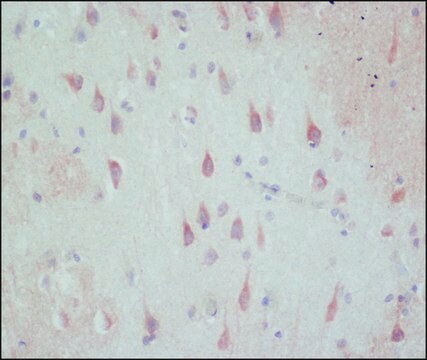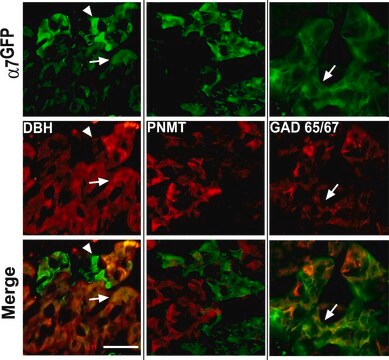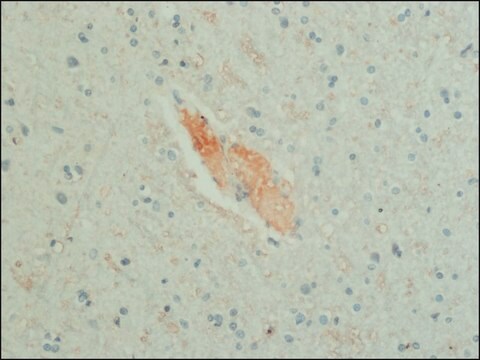G6642
Anti-Glutamate antibody produced in rabbit
whole antiserum
Sinônimo(s):
Anti-Glutamate Ab, Glutamate Detection Antibody, Rabbit Anti-Glutamate
Faça loginpara ver os preços organizacionais e de contrato
About This Item
Produtos recomendados
fonte biológica
rabbit
Nível de qualidade
conjugado
unconjugated
forma do anticorpo
whole antiserum
tipo de produto de anticorpo
primary antibodies
clone
polyclonal
contém
15 mM sodium azide
reatividade de espécies
wide range
técnica(s)
dot blot: 1:15,000
Condições de expedição
dry ice
temperatura de armazenamento
−20°C
modificação pós-traducional do alvo
unmodified
Categorias relacionadas
Descrição geral
The amino acids L-glutamate (Glu) and L-aspartate (Asp) are considered the major excitatory neurotransmitters in the central nervous system (CNS) and represent the most abundant mammalian neurotransmitter class. Both L-glutamate and L-aspartate are present in the brain at high concentrations and are distributed in most excitatory pathways in the CNS. Glu- and Asp-immunoreactivities are localized in high concentrations in synaptic terminals. In nerve terminals, L-glutamate is formed by deamidation of its major precursor, L-glutamine, by the enzyme glutaminase.
The actions of the excitatory amino acids on neurons are mediated by different receptor subtypes. These receptors are coupled to integral ion channels or to a second messenger system which utilizes inositol triphosphate (IP3). L-glutamate and L-aspartate may play an important role in the pathogenesis of certain neurological disorders such as Huntington′s disease, Alzheimer′s disease, epilepsy and brain ischemia. The excitoxic and neurotoxic effects of L-glutamate, leading to extensive neuronal damage, appear to be mediated by the N-methyl-D-aspartate (NMDA) receptor subtype.
The actions of the excitatory amino acids on neurons are mediated by different receptor subtypes. These receptors are coupled to integral ion channels or to a second messenger system which utilizes inositol triphosphate (IP3). L-glutamate and L-aspartate may play an important role in the pathogenesis of certain neurological disorders such as Huntington′s disease, Alzheimer′s disease, epilepsy and brain ischemia. The excitoxic and neurotoxic effects of L-glutamate, leading to extensive neuronal damage, appear to be mediated by the N-methyl-D-aspartate (NMDA) receptor subtype.
Especificidade
The antiserum is evaluated for activity and specificity by dot-blot immunoassay. The antiserum recognizes L-glutamic acid immobilized on an affinity membrane. No cross-reaction is observed with L-aspartic acid, L-glutamine, L-asparagine, and L-alanine. Weak cross-reactivity is observed with Gly-Asp, GABA, β-alanine, glycine and 5-aminovaleric acid (amino acid concentration 5-10 mM). Weak to moderate reaction is observed with L-glutamic acid-containing dipeptides Asp-Glu and Gly-Glu. The antibody may be used to localize glutamate in cell bodies, axons, and terminals of glutamatergic neurons in the CNS.
Imunogênio
L-glutamic acid (Glu).
Aplicação
Applications in which this antibody has been used successfully, and the associated peer-reviewed papers, are given below.
Immunohistochemistry (1 paper)
Immunohistochemistry (1 paper)
Rabbit polyclonal antiserum to L-glutamate may be used in immunohistochemical techniques on formalin- or glutaraldehyde-fixed, vibratome or frozen sections of human or animal tissues. Immunohistochemical methods provide increased anatomical resolution over conventional biochemical methods.
Exoneração de responsabilidade
Unless otherwise stated in our catalog or other company documentation accompanying the product(s), our products are intended for research use only and are not to be used for any other purpose, which includes but is not limited to, unauthorized commercial uses, in vitro diagnostic uses, ex vivo or in vivo therapeutic uses or any type of consumption or application to humans or animals.
Não está encontrando o produto certo?
Experimente o nosso Ferramenta de seleção de produtos.
Código de classe de armazenamento
10 - Combustible liquids
Classe de risco de água (WGK)
WGK 3
Ponto de fulgor (°F)
Not applicable
Ponto de fulgor (°C)
Not applicable
Escolha uma das versões mais recentes:
Já possui este produto?
Encontre a documentação dos produtos que você adquiriu recentemente na biblioteca de documentos.
J Turesson et al.
The Journal of experimental biology, 206(Pt 7), 1251-1259 (2003-02-27)
Glutamate microinjected into the vagal sensory area in the medulla produces cardiorespiratory responses mimicking oxygen chemoreflexes in fish. Here we directly investigate whether these reflexes are dependent on the ionotropic N-methyl-D-aspartate (NMDA) glutamate receptor. Fish were equipped with opercular, branchial
Nigel S Bamford et al.
The Journal of neuroscience : the official journal of the Society for Neuroscience, 24(43), 9541-9552 (2004-10-29)
Normal striatal function is dependent on the availability of synaptic dopamine to modulate neurotransmission. Within the striatum, excitatory inputs from cortical glutamatergic neurons and modulatory inputs from midbrain dopamine neurons converge onto dendritic spines of medium spiny neurons. In addition
Ian W Jones et al.
Journal of neuroscience methods, 134(1), 65-74 (2004-04-23)
Alpha 7 subunit-containing nicotinic acetylcholine receptors (alpha7* nAChR) are involved in a variety of functions in the mammalian brain, including modulating neurotransmitter release and synaptic plasticity. Identifying the precise cellular distribution of alpha7* nAChRs with respect to the local neurochemical
A Popratiloff et al.
Neuroscience, 175, 328-343 (2010-12-07)
In the vestibular nuclei, GABAergic and glycinergic neurons play important roles in signal processing for normal function, during development, and after peripheral vestibular lesions. The chicken tangential nucleus is a major avian vestibular nucleus, whose principal cells are projection neurons
Pingwen Xu et al.
The Journal of clinical investigation, 125(7), 2861-2876 (2015-06-23)
Estrogen receptor-α (ERα) activity in the brain prevents obesity in both males and females. However, the ERα-expressing neural populations that regulate body weight remain to be fully elucidated. Here we showed that single-minded-1 (SIM1) neurons in the medial amygdala (MeA)
Nossa equipe de cientistas tem experiência em todas as áreas de pesquisa, incluindo Life Sciences, ciência de materiais, síntese química, cromatografia, química analítica e muitas outras.
Entre em contato com a assistência técnica







